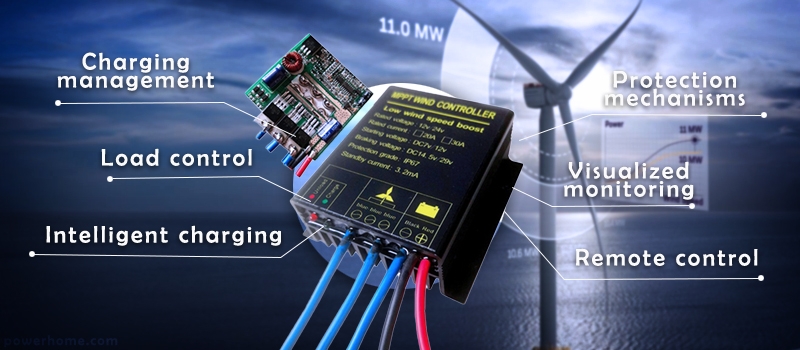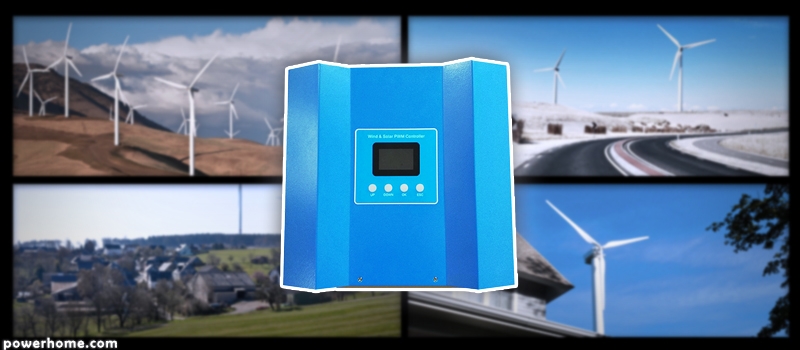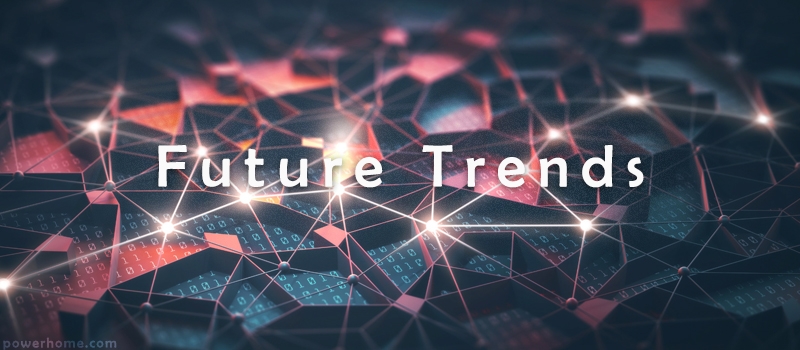Wind turbine controller is a kind of electronic equipment used in wind power generation system, which is mainly responsible for monitoring and controlling the operation status of wind turbine, in order to maximize the energy conversion efficiency and ensure the reliable operation of wind power generation system. The wind turbine controller usually consists of two parts, hardware and software, the hardware part mainly includes sensors, actuators, microprocessors, while the software part mainly includes various control algorithms and programs.
Functions of Wind Turbine Controller

The wind turbine charge controller is an intelligent controller specially designed for wind turbines and power generation systems, which has the following main functions:
- Battery charging management: The charge controller is responsible for controlling the wind turbine's output power to charge the battery to ensure that the battery can be fully charged, while preventing the battery from being overcharged and under-voltage. During the charging process, it will monitor the battery voltage and charging current, and adjust the output power of the wind turbine according to the state of the battery voltage.
- Load control: When the battery voltage is lower than the set value, the battery will provide electricity to the load, at this time, the charge controller will reasonably allocate the output power of the wind turbine according to the current demand of the load to ensure the stability and reliability of the system.
- Intelligent charging: The controller adopts PWM (Pulse Width Modulation) for load dumping to ensure that the battery voltage is always stabilized at the float voltage point, while only releasing the excess power to dump, which ensures the optimal battery charging characteristics, and makes full use of the power.
- Protection mechanisms: Wind turbine controller also has perfect protection functions, such as lightning protection, over-voltage automatic braking, battery reverse connection and open circuit protection, to ensure the safe operation of the wind power system.
- Visualized monitoring: The charge controller will collect real-time data related to the wind turbine's working status, battery charging status, and load conditions. These data are obtained through sensors and monitoring equipment and then transmitted to the central monitoring system. After receiving the data, the central monitoring system will process and analyze it, and display it on the user interface in the form of charts, animation, text, etc.
- Remote control: Through the Internet or a dedicated network, users can establish a remote connection with the wind turbine charge controller and send control commands to the charge controller through the central monitoring system. These commands can include adjusting charging parameters, starting or stopping the charging process, switching operating modes, and more.
In summary, wind turbine controllers play a crucial role in wind power generation systems, not only for the efficient utilization of wind energy resources, but also to ensure the stability and safety of the system. PowerHome provides high-quality wind turbine controllers that can effectively improve the efficiency of wind power generation, prevent the generator from going out of control in case of high wind speeds, and extend the service life of the battery.
Applications of Wind Turbine Controller

With a wide range of application scenarios, wind turbine charge controllers are mainly focused on places that require independent, reliable and sustainable energy supply, such as:
- Remote areas and unpowered areas: In remote mountainous areas, islands, border guard posts and other areas with insufficient or short power supply, wind turbine charge controllers can be combined with wind power generation systems to provide a stable power supply for local residents and facilities.
- Mobile communication base stations and highways: These unmanned areas usually require a continuous and stable power supply. Wind turbine charge controllers can ensure that wind power systems effectively power these facilities, reducing reliance on traditional power grids.
- Rural, pastoral and developing cities: In these areas, distributed wind power systems combined with charge controllers can meet the power needs of local residents and business districts, promoting the use of renewable energy and sustainable development.
- Household power: In areas with abundant wind resources, small wind power systems can be used as part of the household power supply to provide clean electricity for the family. It is particularly suitable for households that wish to reduce carbon emissions and increase their energy self-sufficiency. Both wind power systems and solar power systems have their own pros and cons, visit for details: Wind Turbine vs. Solar Panel for Home Use.
Trends in Wind Turbine Controller

Future trends in wind turbine controllers will focus on improving efficiency, reducing costs, enhancing reliability and intelligence levels. The possible technology trends contain:
- Intelligence and autonomous learning: The controller will integrate more advanced algorithms, such as machine learning and artificial intelligence, to optimize performance and predict maintenance needs. By analyzing historical and real-time data, controllers can autonomously learn and improve control strategies to adapt to changing wind and grid conditions.
- Integrated sensors and Internet of Things (IoT) technology: Controllers will be equipped with more sensors to monitor the various components of the wind turbine, including the blades, gearbox, generator and tower. With IoT technology, these sensors can transmit data in real time, making remote monitoring and troubleshooting possible.
- Modular and scalable design: The design of the wind turbine controllers will be more modular, allowing functional modules to be easily added or replaced according to the needs of different wind turbines and projects. This design will increase the flexibility and maintainability of the system.
- Integrated energy storage systems: As energy storage technology advances, controllers may integrate energy storage management systems to smooth output power fluctuations and improve grid stability and wind power utilization.
With the growing global energy demand and the increasing emphasis on environmental protection, wind power generation, as a clean and renewable energy source, can power many off-grid homes, it has a broad development prospect.
The wind turbine controller, as a key component of the wind power generation system, will also continue to progress in its technology, such as improving control accuracy, response speed, and reducing costs. In addition, with the development of intelligent and networked technology, the wind turbine controller will achieve a higher level of automation and more convenient operation and maintenance management, providing strong support for the wide application of wind power.
(1).png)
(1).png)